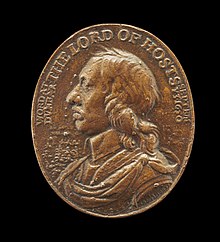| Revision as of 10:57, 3 January 2025 editBoyTheKingCanDance (talk | contribs)Extended confirmed users, Page movers, New page reviewers, Pending changes reviewers176,450 edits Added tags to the page using Page Curation (one source)Tag: PageTriage← Previous edit | Revision as of 11:09, 3 January 2025 edit undoTheBestEditorInEngland (talk | contribs)Extended confirmed users2,801 editsNo edit summaryNext edit → | ||
| Line 33: | Line 33: | ||
| }} | }} | ||
| The '''Dunbar Medal''' is a ] of the ] and was sanctioned by Parliament in 1650 to be awarded to officers and other ranks of the ] who participated in the ] on 3 September 1650. Two versions were produced; one in gold for officers, and one |
The '''Dunbar Medal''' is a ] of the ] and was sanctioned by Parliament in 1650 to be awarded to officers and other ranks of the ] who participated in the ] on 3 September 1650. Two versions were produced; one in gold for officers, and one in silver for other ranks. The Dunbar Medal is thought by historians and ]s to be the first ever military medal to be eligible to every man present in a campaign or engagement, irrespective of rank. It was worn by a cord or chain around the neck.<ref name=Foot01/> | ||
| ] | ] | ||
Revision as of 11:09, 3 January 2025
| This article relies largely or entirely on a single source. Relevant discussion may be found on the talk page. Please help improve this article by introducing citations to additional sources. Find sources: "Dunbar Medal" 1650 – news · newspapers · books · scholar · JSTOR (January 2025) |
Award
| Dunbar Medal | |
|---|---|
 The obverse of a silver Dunbar Medal The obverse of a silver Dunbar Medal | |
| Type | Campaign Medal |
| Awarded for | Campaign service |
| Presented by | Commonwealth of England |
| Eligibility | All officers and other ranks of the New Model Army who participated in the Battle of Dunbar on 3rd September 1650 |
| Campaign(s) | Battle of Dunbar (3 September 1650) |
| Clasps | None |
| Established | 1650 |
| First awarded | 1651 |
The Dunbar Medal is a campaign medal of the Commonwealth of England and was sanctioned by Parliament in 1650 to be awarded to officers and other ranks of the New Model Army who participated in the Battle of Dunbar on 3 September 1650. Two versions were produced; one in gold for officers, and one in silver for other ranks. The Dunbar Medal is thought by historians and numismatists to be the first ever military medal to be eligible to every man present in a campaign or engagement, irrespective of rank. It was worn by a cord or chain around the neck.

Citations
References
- Lessen, Marvin (1981). "THE CROMWELL DUNBAR MEDALS BY SIMON" (PDF). British Numismatic Society. Retrieved 6 February 2021.